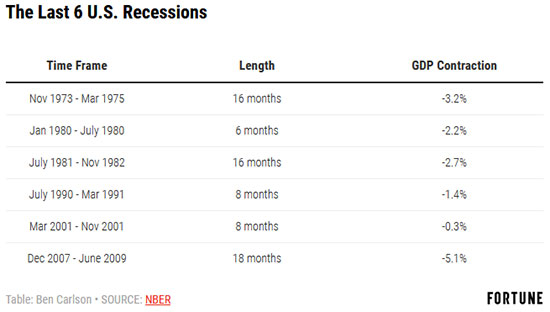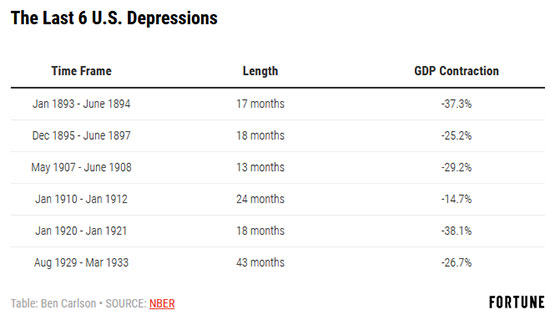衰退和萧条有何区别?让历史告诉我们
|
今天我们对整体“经济”的认知仍是一个较新鲜的事物。实际上,作为衡量经济增速的现代概念,国民生产总值(GDP)一直到大萧条之后才出现。 经济学家西蒙·库兹涅茨因在这个领域中的研究而获得了诺贝尔奖。1934年,库兹涅茨在向美国国会提交的报告中用国民收入这个概念来追踪经济活动。GDP就是由这个概念蜕变而来,但直到二战结束前,它还不是世界各国采用的标准方法。 只要可以衡量经济产出,经济学家就有可能回过头去计算此前的滑坡给经济带来的损害。 19世纪出现过18次经济衰退,6次恐慌,或者说萧条。美国国家经济研究局有纪录的时间最长的GDP收缩期为65个月,从1873年10月到1879年3月,这被称为“长期萧条”。与之相比,1929-1932年的大萧条持续了43个月。 19世纪初土地价格由盛转衰后,恐慌进入了经济词典,指的是造成巨大崩溃的投机性经济阶段。在整个19世纪,人们一直用‘恐慌’来描述如今被称为萧条的情景。政府官员觉得他们需要一些不那么让公众警觉的词汇,就这样,衰退和萧条开始成为不同程度的经济滑坡的代名词。 衰退vs.萧条 衰退和萧条的差别并无标准定义,但萧条一般指经济收缩的幅度较大,而且时间较长。如果用以往的六次衰退和六次萧条进行比较,二者区别一目了然。以下是美国曾经出现的六次衰退: |
The whole idea of "the economy" as we know it today is still a relatively new phenomenon. In fact, the modern concept of gross domestic product (GDP) as a way to measure economic growth wasn't developed until the aftermath of the Great Depression. Simon Kuznets, an economist who won the Nobel Prize for his work in this area, put forth a report to Congress in 1934 using a concept called national income to track economic activity. GDP was bourne out of this idea but it wasn't the standard method used by countries around the globe until the end of WWII. Once economists were able to measure economic output they could go back to calculate the damage previous downturns had on the economy. In the 1800s there were 18 recessions in addition to 6 panics or depressions. The National Bureau of Economic Research (NBER) lists the longest GDP contraction on record as 65 months in length which was from October 1873 to March 1879 in what is known as the Long Depression. In comparison, the Great Depression of 1929-1932 was 43 months long. After a land price boom-bust in the early 1800s, the word panic entered the lexicon and was used to describe speculative economic episodes that resulted in a spectacular collapse. The term ‘panic’ was used for the remainder of the century to describe what is now termed a depression. Government officials decided they needed something that was less alarming to the public which is how the terms recession and depression came to be used to describe economic downturns of varying severity. Recession vs. Depression There is no standard definition of the difference between a recession and a depression but depressions are typically more severe in terms of the magnitude and length of the economic contraction. If we compare the past six recessions with the past six depressions, the distinction becomes clear. Here are the past six U.S. recessions: |

|
而这是以往美国的六次萧条(其中一些在当时被称为恐慌): |
And the past six U.S. depressions (some of which were called panics at the time): |

|
衰退会持续多长时间? 此前的六次衰退中,GDP平均降幅为2.5%,持续时间平均为12个月。而以往六次萧条的GDP平均降幅为28.5%,平均持续时间为22个月。值得注意的是,其中多次萧条,或者说恐慌出现之际,美国或多或少还是一个新兴市场。在19世纪和20世纪早期,经济活动差不多和股市一样起伏不定。相比之前,现在经济要成熟得多,但股市仍表现出与之类似的波动性。 如今,专家和职业投资人都在将目前的经济状况和1929年秋天,也就是大萧条即将到来时的经济形势相比。任何用大萧条来进行类比的人对历史的理解都不够深刻。即使是2007-2009年的严重金融危机也无法和二战前的那些经济滑坡相提并论,而且那场危机不知因何并未演化成全面衰退。 然而,一些较小的国家依然能感受到恐慌,或者说萧条的痛楚。比如说,2008-2013年希腊GDP下跌了26%,失业率飙升至近30%。这两个数字都比美国的大萧条更为严重。 对大多数个人的经济处境来说,这些经济定义可能不那么重要。小幅衰退对某些人来说可能像是一个机会,但对其他人而言则是一次萧条。这完全取决于人们的工作、家庭以及财务状况。 美国的“经济”价值超过20万亿美元。我们对这台巨型机器的认知往往被个人感受所左右,在经济扩张和收缩时都是如此。 对于经济来说,没有什么是不可能的,因为我们对未来局势一无所知,但我们可以指出的一个事实是,现在美国经济比过去要稳定得多。(财富中文网) 本·卡尔森是特许金融分析师,在Ritholtz Wealth Management担任机构资产管理业务主管。 译者:Charlie 审校:夏林 |
How long do recessions last? The average GDP contraction over the past six recessions was -2.5%, lasting 12 months on average. The average GDP contraction over the past six depressions was -28.5%, lasting 22 months on average. It is worth noting that the United States was more or less an emerging market when many of these depressions and panics occurred. Economic activity was nearly as volatile as the stock market during the 19th century and early part of the 20th century. The economy is far more mature now while the stock market still exhibits similar levels of volatility. There are pundits and professional investors alike these days who evoke comparisons between today's economy and what began in the fall of 1929 prior to the onset of the Great Depression. Anyone making Great Depression analogies hasn't read enough history books. Even the Great Financial Crisis of 2007-2009, which somehow didn't morph into an all-out depression, looks tame when compared to economic downturns in the pre-WWII era. There are, however, smaller countries that can find themselves in the throes of a panic or depression. Greece, for instance, saw GDP decline 26% from 2008-2013 and unemployment spike to nearly 30%. Both of these figures were worse than what the U.S. experienced during the Great Depression. For most individuals, these economic definitions likely don't matter all that much for their personal situation. A shallow recession can feel like an opportunity for some but a depression for others. It all depends on the context in terms of your job, family, and financial situation. "The economy" in the United States is worth more than $20 trillion. Our feelings about this massive machine are often swayed by our own personal experiences with it, which is true of both economic expansions and downturns. Nothing is impossible when it comes to the economy because we have no idea what the future holds but we can say for a fact that the U.S. economy is much more stable now than it was in the past. Ben Carlson, CFA is the Director of Institutional Asset Management at Ritholtz Wealth Management. |













